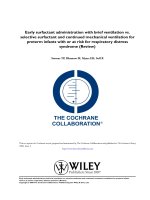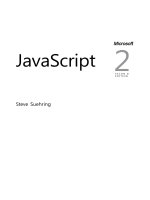2011 pediatric and neonatal mechanical ventilation 2nd ed 2011
Bạn đang xem bản rút gọn của tài liệu. Xem và tải ngay bản đầy đủ của tài liệu tại đây (7.18 MB, 309 trang )
Pediatric and Neonatal
Mechanical Ventilation
Pediatric and Neonatal
Mechanical Ventilation
Second Edition
Praveen Khilnani MD FAAP FCCM (USA)
Senior Consultant and Incharge
Pediatric Intensivist and Pulmonologist
Max Hospitals, New Delhi, India
Foreword
RN Srivastav
®
JAYPEE BROTHERS MEDICAL PUBLISHERS (P) LTD
New Delhi • St Louis • Panama City • London
Published by
Jaypee Brothers Medical Publishers (P) Ltd
Corporate Office
4838/24, Ansari Road, Daryaganj, New Delhi 110 002, India
Phone: +91-11-43574357, Fax: +91-11-43574314
Offices in India
• Ahmedabad, e-mail:
• Bengaluru, e-mail:
• Chennai, e-mail:
• Delhi, e-mail:
• Hyderabad, e-mail:
• Kochi, e-mail:
• Kolkata, e-mail:
• Lucknow, e-mail:
• Mumbai, e-mail:
• Nagpur, e-mail:
Overseas Offices
•
•
•
North America Office, USA, Ph: 001-636-6279734
e-mail: ,
Central America Office, Panama City, Panama, Ph: 001-507-317-0160
e-mail: , Website: www.jphmedical.com
Europe Office, UK, Ph: +44 (0) 2031708910
e-mail:
Pediatric and Neonatal Mechanical Ventilation
© 2011, Jaypee Brothers Medical Publishers
All rights reserved. No part of this publication and DVD-ROM should be reproduced, stored in a
retrieval system, or transmitted in any form or by any means: electronic, mechanical, photocopying,
recording, or otherwise, without the prior written permission of the editor and the publisher.
This book has been published in good faith that the material provided by contributors is
original. Every effort is made to ensure accuracy of material, but the publisher, printer and
editor will not be held responsible for any inadvertent error(s). In case of any dispute, all
legal matters are to be settled under Delhi jurisdiction only.
First Edition: 2006
Second Edition: 2011
ISBN 978-93-5025-245-1
Typeset at JPBMP typesetting unit
Printed at Ajanta Offset
Dedicated to
my mother
Late Shrimati Laxmi Devi Khilnani
who left for heavenly abode on 13th May, 2001.
She always knew I could do it whenever I thought I couldn’ t.
She was the one who taught me to be always optimistic and hardworking.
God will take care of the rest.
Late Smt Laxmi Devi Khilnani
(19th Jan, 1930 – 13th May, 2001)
Contributors
Jeffrey C Benson
Pediatric Intensivist
Children’s Hospital of Wisconsin
Wisconsin, Michigan, USA
Satish Deopujari
Consultant Pediatric Intensivist
Child Hospital
Nagpur, Maharashtra, India
Garima Garg
PICU Fellow
Max Superspeciality Hospital
New Delhi, India
Shipra Gulati
PICU Fellow
Max Superspeciality Hospital
New Delhi, India
Praveen Khilnani
Senior Consultant and Incharge
Pediatric Intensivist and
Pulmonologist, Max Hospitals
New Delhi, India
Sankaran Krishnan
Pediatric Pulmonologist
Cornell University
New York, USA
Anjali A Kulkarni
Senior Consultant Neonatologist
IP Apollo Hospitals
New Delhi, India
Veena Raghunathan
PICU Fellow
Sir Ganga Ram Hospital
New Delhi, India
Meera Ramakrishnan
Sr Consultant Incharge PICU
Manipal Hospital
Bengaluru, Karnataka, India
S Ramesh
Pediatric Anesthesiologist
KK Child Trust Hospital
Chennai, Tamil Nadu, India
Suchitra Ranjit
Incharge PICU
Apollo Childrens Hospital
Chennai, Tamil Nadu, India
Reeta Singh
Consultant Pediatrics
Sydney, Australia
Anil Sachdev
Senior Consultant PICU
Sir Ganga Ram Hospital
New Delhi, India
Ramesh Sachdeva
Pediatric Intensivist
Vice President
Children’s Hospital of Wisconsin
Wisconsin, Michigan, USA
Pediatric and Neonatal Mechanical Ventilation
viii
Deepika Singhal
Consultant Pediatric Intensivist
Pushpanjali Crosslay Hospital
Ghaziabad, Uttar Pradesh, India
Nitesh Singhal
Consultant
Pediatric Intensivist
Max Superspeciality Hospital
New Delhi, India
Rajiv Uttam
Senior Consultant
Pediatric Intensivist
Dr BL Kapoor Memorial Hospital
New Delhi, India
Foreword
The author of this book, Pediatric and Neonatal Mechanical Ventilation, is an
experienced pediatric intensivist with over 30 years of experience and
expertise in the field of anesthesia, pediatrics and critical care. He has been
involved in training and teaching at various conferences and mechanical
ventilation workshops in India as well as at an international level. The text
presented is intended to be a practical resource, helpful to beginners and
advanced pediatricians who are using mechanical ventilation for newborns
and older children.
RN Srivastav
Senior Consultant
Apollo Center for Advanced Pediatrics
Indraprastha Apollo Hospital
New Delhi, India
Preface to the
Second Edition
After the first edition came out in 2006, Pediatric and Neonatal Mechanical
Ventilation became instantly popular with pediatric residents in the
Pediatric Intensive Care Unit (PICU) due to its small size and simple and
practice-oriented approach.
Recently, more advances have come up in the field of mechanical
ventilation including newer modes such as airway pressure release
ventilation, neurally adjusted ventilatory assist (NAVA) and high
frequency oscillatory ventilation (HFOV).
Newer ventilators with sophisticated microchip technology are able to
offer better ventilation with precision with graphics and monitoring of
dynamic parameters on a real-time basis as well as sophisticated alarm
systems to check pressures (over distention) and volumes delivered to the
patient via the breathing circuit (leaks if any). Newer advances such as
FiO2 weaning by feedback loop with real-time sensing of SpO2 in the patient
by the microchip built in the ventilator are soon going to be a reality.
In the second edition, newer chapters on specific scenarios of Ventilation
in Asthma, ARDS, Extracorporeal Membrane Oxygenation (ECMO),
Patient ventilator synchrony have been added. Flow charts have also been
included in most of the chapters for ready reference. Some newer
ventilators and their information have also been added in chapter on
commonly available ventilators.
I sincerely hope that this book will continue to be of practical use to the
residents and fellows in the pediatric and neonatal intensive care unit.
Praveen Khilnani
Preface to the
First Edition
As the field of pediatric critical care is growing, the need for a simple and
focused text of this kind has been felt for past several years in this part of
the world for pediatric mechanical ventilation. Effort has been made to
present the method and issues related to mechanical ventilation of neonate,
infant and the older child. Basic and some advanced modes of mechanical
ventilation have been described for advanced readers, topics like high
frequency ventilation, ventilator graphics and inhaled nitric oxide have
also been included. Finally, some commonly available ventilators and their
features and utility in this part of the world have been discussed. I hope
this book will be helpful to pediatricians, residents and neonatal pediatric
intensivists who are beginning to work independently in an intensive care
setting, or have already been involved in care of critically ill neonates and
children.
Praveen Khilnani
Acknowledgments
Besides a description of available evidence and using my personal
experience of mechanical ventilation of neonates and children for past
20 years, I have taken the liberty of using the knowledge and experience
of my teachers Prof I David Todres (Professor of Anesthesia and Pediatrics,
Harvard University, Boston, MA), Prof William Keenan (Director of
Neonatology, Glennon Children Hospital, St Louis University, St Louis,
MO), Prof Uday Devaskar (Director of Neonatology, UCLA, CA), and
authorities such as Dr Alan Fields (PICU, Children’s National Medical
Center, Washington DC), and Robert Kacemarek (Director, Respiratory
Care at Massachusetts General Hospital, Boston, MA).
I would like to give special acknowledgement to my esteemed
colleagues such as Dr Shekhar Venkataraman (PICU, Pittsburgh Children’s
Hospital, Pittsburgh, PA), Dr S Ramesh (Anesthesiologist, Chennai),
Dr Ramesh Sachdeva (PICU, Children’s Hospital of Wisconcin, Milwaukie,
WI), Dr Meera Ramakrishnan (PICU, Manipal Hospital), Dr Sankaran
Krishnan (Pediatric Pulmonologist, Cornell University, New York),
Dr Balaramachandran (PICU, KKCT Hospital, Chennai), Dr Krishan Chugh
and Anil Sachdev (PICU, SGRH, Delhi), Dr Rajesh Chawla (MICU, IP
Apollo Hospital, Delhi), Dr RK Mani (MICU, Artemis Healthcare Institute,
Delhi), Dr Rajiv Uttam (PICU, BL Kapoor Memorial Hospital, Delhi),
Dr S Deopujari (Nagpur), Dr S Ranjit (Chennai), Dr Dinesh Chirla (Rainbow
Children’s Hospital) and Dr VSV Prasad (Lotus Children’s Hospital,
Hyderabad), Dr Deepika Singhal, Pushpanjali Hospital, Ghaziabad,
Dr Anjali Kulkarni and Dr Vidya Gupta (Neonatology, IP Apollo Hospital,
Delhi) and many other dear colleagues for constantly sharing their
knowledge and experience in the field of neonatal and pediatric mechanical
ventilation and providing their unconditional help with various national
level pediatric ventilation workshops and CMEs.
Finally, the acknowledgment is due to my family without whose wholehearted support this task could not have been accomplished.
Contents
1. Structure and Function of Conventional Ventilator
Praveen Khilnani, S Ramesh
• Ventilator
1
2. Mechanical Ventilation: Basic Physiology
Praveen Khilnani
• Basic Respiratory Physiology
• Applied Respiratory Physiology for Mechanical Ventilation
9
1
9
16
3. Oxygen Therapy
Satish Deopujari, Suchitra Ranjit
• Definition
• Physiology
20
4. Basic Mechanical Ventilation
Praveen Khilnani, Deepika Singhal
• Indications of Mechanical Ventilation
• Basic Fundamentals of Ventilation
34
5. Advanced Mechanical Ventilation: Newer Modes
Praveen Khilnani
• Inverse Ratio Ventilation (IRV)
• Airway Pressure Release Ventilation (APRV)
• Pressure Support Ventilation (PSV)
• Pressure-regulated Volume Control (PRVC)
• Proportional Assist Ventilation (PAV)
• Nonconventional Techniques
• Neurally Adjusted Ventilatory Assist (NAVA)
57
20
20
36
38
57
58
60
61
61
62
65
6. Patient Ventilator Dyssynchrony
Deepika Singhal, Praveen Khilnani
• Ventilator-related Factors that affect Patient-ventilator
Interaction
• Trigger Variable
• Ineffective Triggering
70
7. Blood Gas and Acid Base Interpretation
Nitesh Singhal, Praveen Khilnani
• Acidosis
• Alkalosis
76
70
71
71
76
76
Pediatric and Neonatal Mechanical Ventilation
xviii
•
•
•
•
•
•
•
•
•
Buffering System
Homeostasis
Pathophysiology
Metabolic Acidosis
Treatment
Metabolic Alkalosis
Respiratory Acidosis
Respiratory Alkalosis
Mixed Acid-base Disorders
8. Care of the Ventilated Patient
Meera Ramakrishnan, Garima Garg
• Physiotherapy
• Appendix: Humidification and Mechanical Ventilation
9. Ventilator Graphics and Clinical Applications
Praveen Khilnani
• Technique of Respiratory Mechanics Monitoring
• Types of Waveforms
• Scalars
• Loops
• Abnormal Waveforms
76
77
77
77
79
80
82
83
85
88
88
107
110
111
111
117
119
10. Ventilation for Acute Respiratory Distress Syndrome
Shipra Gulati, Praveen Khilnani
• Epidemiology of Acute Lung
• Diagnosing Acute Lung Injury
• Management of Pediatric ALI and ARDS
• Respiratory Support in Children with ALI and ARDS
• Endotracheal Intubation and Ventilation
• Rescue Therapies for ChIldren with ALI/ARDS
• Potentially Promising Therapies for Children with
ALI/ARDS
128
11. Mechanical Ventilation in Acute Asthma
Anil Sachdev, Veena Raghunathan
• Criteria for Intubation
• Intubation Technique
• Sedation during Intubation and Ventilation
• Effects of Intubation
• Ventilation Control
• Medical Management of Asthma in the Intubated Patient
• Noninvasive Mechanical Ventilation
137
12. Weaning from Mechanical Ventilation
Sankaran Krishnan, Praveen Khilnani
• Determinants of Weaning Outcome
• Extubation
147
13. Complications of Mechanical Ventilation
Praveen Khilnani
• Complications Related to Adjunctive Therapies
162
128
128
129
129
130
132
132
137
138
138
139
140
144
145
148
158
165
14. Non-Invasive Ventilation
167
Rajiv Uttam, Praveen Khilnani
• Mechanism of Improvement with Non-invasive Ventilation 167
15. Neonatal CPAP (Continuous Positive Airway Pressure)
Praveen Khilnani
• Definition
• Effects of CPAP in the Infant with Respiratory Distress
• The CPAP Delivery System
xix
181
181
181
182
192
17. High Frequency Ventilation
Jeffrey C Benson, Ramesh Sachdeva, Praveen Khilnani
• Ventilator Induced Lung Injury
• Protective Strategies of Conventional Mechanical Ventilation
• Basic Concepts of HFV (High Frequency Ventilation)
• Types of High Frequency Ventilation
• Clinical Application
• Practical Aspects of High Frequency Ventilation of
Pediatric and Neonatal Patients
202
18. Inhaled Nitric Oxide
Rita Singh, Praveen Khilnani
227
19. Extracorporeal Membrane Oxygenation
Ramesh Sachdeva, Praveen Khilnani
• Recent Evidence on Use of ECMO
237
20. Commonly Available Ventilators
Praveen Khilnani
• VELA Ventilator: Viasys Health Care (USA)
• Neonatal Ventilator Model Bearcub 750 PSV–Viasys
Health Care (USA)
• Ventilator Model Avea- Viasys Health Care (USA)
• The SLE 2000 - For Infant Ventilation
• SLE 5000
• The Puritan Bennett® 840™ Ventilator
247
202
203
203
203
205
208
244
249
250
251
264
266
268
Appendix 1: Literature Review of Pediatric Ventilation
271
Appendix 2: Adolescent and Adult Ventilation
276
Index
283
Contents
16. Neonatal Ventilation
Anjali A Kulkarni
1
Chapter
Structure and Function of
a Conventional Ventilator
Praveen Khilnani, S Ramesh
This chapter is intended to get the reader familiar with basic aspects of the
ventilator as a machine and its functioning. We feel this has important
bearing in the management issues of a critically-ill child requiring
mechanical ventilation.
VENTILATOR
A ventilator is an automatic mechanical device designed to move gas into
and out of the lungs. The act of moving the air into and out of the lungs is
called breathing, or more formally, ventilation.
Simply, compressed air and oxygen from the wall is introduced into a
ventilator with a blender, which can deliver a set FiO2. This air oxygen
mixture is then humidified and warmed in a humidifier and delivered to
the infant by the ventilator via the breathing circuit.
The peak inspiratory pressure (PIP) or tidal volume (Vt), positive end
expiratory pressure (PEEP), inspiratory time and respiratory rate are set
on the ventilator.
The closing of the exhalation valve initiates a positive pressure
mechanical breath. At the end of the preset inspiratory time, the exhalation
valve is opened, permitting the infant to exhale. If this end is partly
occluded during expiration, a PEEP is generated in the circuit proximal to
the occlusion (or CPAP if the infant is breathing spontaneously). Expiration
is passive and gas continues to flow delivering the set PEEP.
Parts of a Ventilator
1. Compressor: This is required to provide a source of compressed air. An
in-built wall source of compressed air, if available, can be used instead.
It draws air from the atmosphere and delivers it under pressure (50
PSI) so that the positive pressure breaths can be generated.
The compressor has a filter which should be washed with tap water
daily or as directed. If this is not done, it greatly increases the load on the
compressor. The indicator on the compressor should always be in the
green zone. It should not be placed too close to the wall as it may get
overheated. There should be enough space to permit air circulation
around it.
Pediatric and Neonatal Mechanical Ventilation
2
2. Control panel: The controls that are found on most pressure-controlled
ventilators include the following:
• FiO2
• Peak Inspiratory Pressure: PIP (in pressure controlled ventilators).
• Tidal volume/Minute volume (in volume controlled ventilators).
• Positive End Expiratory Pressure (PEEP).
• Respiratory Rate (RR).
• Inspiratory Time (Ti).
• Flow rate.
The other parameters displayed on the ventilator include mean airway
pressure (MAP), I:E ratio (ratio of the inspiratory time to expiratory time).
The expired tidal volume will be displayed in all volume controlled
ventilators and some pressure controlled ventilators.
Newer ventilator models have digital display controls. Some ventilators
also display waveforms, which show the pulmonary function graphically.
3. Humidifier: Since the endotracheal tube bypasses the normal
humidifying, filtering and warming system of the upper airway, the
inspired gases must be warmed and humidified to prevent
hypothermia, inspissation of secretions and necrosis of the airway
mucosa.
Types of humidifiers available:
a. Simple humidifier: It heats the humidity in inspired gas to a set
temperature, without a servo control. The disadvantage is excessive
condensation in the tubings with reduction in the humidity along
with cooling of the gases by the time they reach the patient.
b. Servo-controlled humidifier with heated wire in the tubings: These
prevent accumulation of condensate while ensuring adequate
humidification. Optimal temperature of the gases should be 36-37°C
and a relative humidity of 70 percent at 37°C. If the baby is nursed
in the incubator, temperature monitoring must take place before
the gas enters the heated field. At least some condensation must
exist in the inspiratory limb which shows that humidification is
adequate. The humidifier chamber must be changed daily. It should
be adequately sterilized or disposable chambers may be used.
4. Breathing circuit: It is preferable to use disposable circuits for every
patient. Special pediatric circuits are available in the market with water
traps. If reusable circuits are used, they must be changed every 3 days.
Reusable circuits are sterilized by gas sterilization or by immersion in
2 percent glutaraldehyde for 6-8 hours and then thoroughly rinsing
with sterile water. Disposable circuits may be changed every week.
Terminology
Ventilatory controls that can be altered in mechanical ventilation include
the following:
1. Inspired oxygen concentration (FiO2).
2. Peak inspiratory pressure (PIP).
Flow rate.
Positive end-expiratory pressure (PEEP).
Respiratory rate (RR),or Frequency (f).
Inspiratory/Expiratory Ratio (I:E Ratio).
Tidal volume (in volume controlled ventilators).
Pressure support.
Inspired Oxygen Concentration (FiO2)
An improvement in oxygenation may be accomplished either by increasing
the inspired oxygen concentration (FiO2) or by different ventilator settings.
1. Increasing peak inspiratory pressure (PIP)
2. Increasing inspiratory/expiratory ratio
3. Applying a positive pressure before the end of expiration (PEEP).
FiO2 is adjusted to maintain an adequate PaO2. High concentrations of
oxygen can produce lung injury and should be avoided. The exact threshold
of inspired oxygen that increases the risk of lung injury is not clear. A FiO2
of 0.5 is generally considered safe. In patients with parenchymal lung
disease with significant intrapulmonary shunting, the major determinant
of oxygenation is lung volume which is a function of the mean airway
pressure. With a shunt fraction of > 20 percent oxygenation may not be
substantially improved by higher concentrations of oxygen.
The administration of oxygen and its toxicity is a clinical problem in
the treatment of neonates, especially low birth weight infants.
The developing retina of the eye is highly sensitive to any disturbance
in its oxygen supply. Oxygen is certainly a critical factor (hyperoxia,
hypoxia), but a number of other factors (immaturity, blood transfusions,
PDA, vitamin E deficiency, infections) may interact to produce various
degrees of Retinopathy of Prematurity (ROP).
Another complication of oxygen toxicity induced by artificial ventilation
in the neonatal period is a chronic pulmonary disease, Bronchopulmonary
Dysplasia (BPD), mostly seen in premature infants ventilated over long
periods with a high inspiratory peak pressure and high oxygen
concentration.
High oxygen concentration may play a role in the pathogenesis of BPD,
but recent studies have shown, that the severity of the disease is correlated
to the Peak inspiratory pressure (PIP) during artificial ventilation rather
than to the doses of supplementary oxygen.
Peak Inspiratory Pressure (PIP)
Peak Inspiratory Pressure is the major factor in determining tidal volume
in infants treated with time cycled or pressure cycled ventilators. Most
ventilators indicate inspiratory pressure on the front and it can be selected
directly.
The starting level of PIP must be considered carefully. Critical factors
that must be evaluated are the infant’s weight, gestational age (the degree
of maturity), the type and severity of the disease and lung mechanics—
such as lung compliance and airway resistance.
3
Structure and Function of a Conventional Ventilator
3.
4.
5.
6.
7.
8.
Pediatric and Neonatal Mechanical Ventilation
4
The lowest PIP necessary to ventilate the patient adequately is optimal.
In most cases, associated with increased tidal volume, increased CO2
elimination and decreased PaCO2.
Mean airway pressure will rise and thus improve oxygenation.
If PIP is minimized, there is a decreased incidence of barotrauma with
resultant air leak (pneumothorax and pneumomediastinum) and BPD.
Hacker et al demonstrated that more rapid ventilator rates and lower
PIP are associated with a decreased incidence of air leaks—a mode of
ventilation which may be recommended in infants with congenital
diaphragmatic hernia.
High PIP may also impede venous return and lower cardiac output.
Flow Rate
The flow rate is important determinant during the infant’s mechanical
ventilation of attaining desired levels of peak inspiratory pressure, wave
form, I:E ratio and in some cases, respiratory rate.
In general, a minimum flow at least two times the minute volume
ventilation is usually required. Most pressure ventilators operate at flows
of 6-10 liters per minute.
If low flow rates are used, there will be a slower inspiratory time (Ti)
resulting in a pressure curve of sine wave form and lowering the risk of
barotrauma.
Too low flow relative to minute volume, may result in hypercapnia
and accumulation of carbon dioxide in the system.
High inspiratory flow rates are needed if square wave forms are desired
and also when the inspiratory time is shortened in order to maintain an
adequate tidal volume. Carbon dioxide retention in the ventilator tubing
will be prevented at high flow rates.
A serious side effect of high flow rate is an increased risk of alveolar
rupture, because maldistribution of ventilation results in a rapid pressure
increase in the non-obstructed or non-atelectatic alveoli.
Positive End Expiratory Pressure (PEEP)
Positive pressure applied at the end of expiration to prevent a fall in
pressure to zero is called Positive End Expiratory Pressure (PEEP).
PEEP stabilizes alveoli, recruits lung volume and improves the lung
compliance. The level of PEEP depends on the clinical circumstances.
Application of PEEP results in a higher mean airway pressure, and mean
lung volumes.
The goals of PEEP are:
1. Increasing FRC (Functional Residual Capacity) above closing volume
to prevent alveolar collapse
2. Maintaining stability of alveolar segments
3. Improvement in oxygenation, and
4. Reduction in work of breathing.
Respiratory Rate (RR) or Frequency (f)
Respiratory rate, together with tidal volume, determines the minute
ventilation. Depending on the infant’s gestational age and the underlying
disease, the resulting pulmonary mechanics (resistance, compliance)
require the use of slow or rapid ventilatory rates.
Moderately high ventilator rates (60-80 breaths per minute) employ a
lower tidal volume and therefore, lower inspiratory pressures (PIP) are
used to prevent barotrauma.
High rates may also be required to hyperventilate infants with
pulmonary hypertension and right-to-left shunting to achieve an increased
pH and reduced PaCO2, thereby reducing pulmonary arterial resistance
and shunting associated with increased PaCO2. Respiratory rate is the
primary determinant of minute ventilation and hence, CO2 removal from
lungs.
Tidal volume × RR, increasing the RR lowers the PaCO2 level. A
respiratory rate of 40-60 is usually sufficient in most conditions. High rates
are necessary in Meconium Aspiration Syndrome (MAS) where CO2
retention is a major problem. It must be recognized that increasing the RR
while keeping the IT the same, shortens expiration and may lead to
inadequate emptying of lungs and inadvertent PEEP.
5
Structure and Function of a Conventional Ventilator
The optimum PEEP is the level at which there is an acceptable balance
between the desired goals and undesired adverse effects. The desired goals
are: (1) reduction in inspired oxygen concentration—nontoxic levels
(usually less than 50%); (2) maintenance of PaO2 or SaO2 of > 60 mm Hg or
> 90 percent respectively, (3) improving lung compliance; and
(4) maximizing oxygen delivery.
Arbitrary limits cannot be placed to determine the level of PEEP or
mean airway pressure that will be required to maintain adequate gas
exchange. When the level of PEEP is high, peak inspiratory pressure may
be limited to prevent it from reaching dangerous levels that contribute to
air leaks and barotrauma. In children with tracheomalacia or
bronchomalacia, PEEP decreases the airway resistance by distending the
airways and preventing dynamic compression during expiration.
The compliance may be improved. Improved ventilation may result
(improvement in ventilation/perfusion ratio) by preventing alveolar
collapse.
Low levels of PEEP (2-3 cm H2O) are often used during weaning from
the ventilator in conjunction with low IMV rates only for a short amount
of time.
Medium levels of PEEP (4-7 cm H2O) are commonly used in moderately
ill patients.
High levels of PEEP (8-15 cm H2O) benefit oxygenation in ARDS (Acute
Respiratory Distress Syndrome); tidal volume, and PaO2 increases.
Higher PEEP level can also reduce blood pressure and cardiac output
explained by a reduced preload. Very high levels of PEEP results in overdistention and alveolar rupture leading to increased incidence of
pneumothorax and pneumomediastinum.









